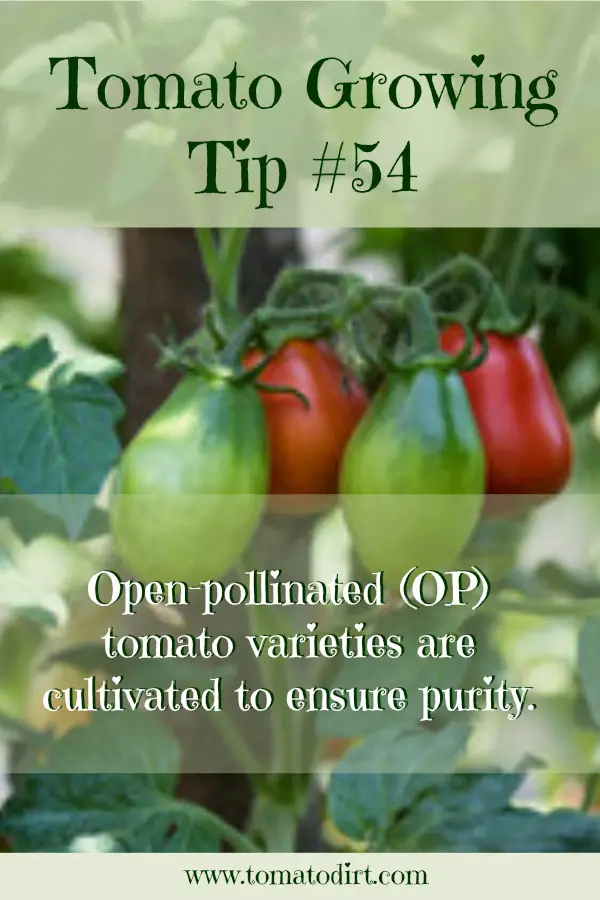Saving Tomato Seeds FAQs: Frequently Asked Questions
Since 2010, Tomato Dirt has garnered 4.8+ million views, making it the web’s leading online source for growing tomatoes in the home garden. Award-winning writer and Tomato Dirt owner Kathy Widenhouse has helped thousands of home gardeners grow healthier tomatoes. Be one of them when you get Tomato Dirt’s Growing Guide here.
Tomato Dirt answers your saving tomato seeds FAQs (frequently asked questions).
Q. Is it possible to save seeds from hybrid tomatoes?
A. Yes. However, be warned that hybrid tomato seeds will likely not produce tomatoes that are true to their type. By definition, a hybrid tomato plant is a cross between two different varieties. A hybrid variety can be re-created only by crossing the exact same two types of parent plants.
Q. How do I know if my current tomato plants are hybrids or heirlooms (open pollinated)?
A. Every plant and seed packet you purchase is labeled. Look for “hybrid” or “F1 Hybrid” after the tomato’s variety name to determine if it is a hybrid.
Q. If I choose to save a few hybrid seeds, is there a special procedure I should follow?
A. No. Use the same seed saving method for any kind of tomato seeds, both heirloom and hybrid.
Q. Will properly saved hybrid tomato seeds grow?
A. Yes. In fact, many gardeners find it interesting to save and grow hybrid tomato seeds because the results are unpredictable. Tomato plants grown from saved hybrid seeds can bear excellent and tasty fruit. If you’re not concerned about growing a “pure” variety, give hybrid seed saving a try with one or two varieties a year. If you track and label saved seeds carefully, who knows – you may produce a new tomato variety from your garden by saving hybrid seeds.
Q. Can I save seeds from a plant that’s had early blight, late blight, or various wilt diseases?
A. Yes. What’s most important with saving seeds is the health of the tomato fruit. Blights and wilts originate in the soil, not the seed.
Q. Why do tomato seeds need to be fermented?
A. Tomato seeds are encased in a gel coating. Fermentation removes that casing. Fermentation also kills disease-causing microbes that can infect next year’s plants. And fermentation ensures a better germination rate.
Q. How do I know when my tomato seeds are completely dried?
A. Drying takes 1-3 weeks. Dried seeds will be very hard. You won’t be able to bite or smash thoroughly dried seeds easily. An adequately dried seed makes a faint snapping noise when broken in half. Seeds that bend rather than snap need to be dried longer.
Q. What’s considered to be a good germination rate?
A. 80% germination is average for seeds properly fermented, sorted, dried, and stored by the home gardener. Often the rate is even higher. (Federal standards require 75% germination rate for commercially-produced seeds.)
Q. How long can saved tomato seeds can be used?
A. If tomato seeds are properly fermented, dried, and stored, they can last up to 10 years with a germination rate of 50%. If used within 4-7 years, the germination rate will be even better.
Q. Do home-saved seeds produce better plants than commercially purchased seeds?
A. Gardeners report that seeds saved repeatedly from a particular variety grow stronger, healthier plants each subsequent year. Plants adapt to climate and conditions and pass along those traits to later generations.
More on saving tomato seeds
Why save tomato seeds? 10 great reasons ...
How to save tomato seeds to plant next year ...
Which tomato varieties should you save for next year?
Easy seed saving method for tomato seeds ...
How to make your own tomato seed tape ...
How to take end of season notes about your tomato garden ...
Seed Trading 101: how to trade tomato seeds ...
Where to find seed exchange forums to swap seeds ...
How to grow tomatoes from seeds ...
Get more tips on our Saving Tomato Seeds Pinterest board...
Return from Save Tomato Seeds FAQs to Tomato Dirt home
As an Amazon Associate and Rakuten Advertising affiliate I earn from qualifying purchases.
SHARE THIS PAGE:
FREE! 10 Must-Know Tomato Growing Tips: 20-page guide
Get yours here:





New! Comments
Have your say about what you just read! Leave a comment in the box below.